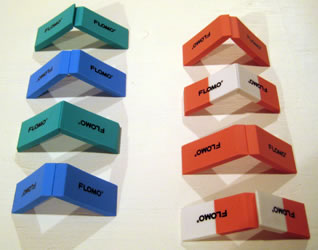


The Invisible Arts Club (Gateshead, U.K.) publishes anonymous editions that faintly echo the Concrete Poetry and Minimalism movements of the 1960s. The works tend to be spare, matter-of-fact, and poetic.
The Club was started by Abigail ("Abbe") Hemmingford, an innovative curator (but rumored to be an unpleasant person) and her husband Malcolm Sutherland, a former artist. Hemmingford started her career in the early 1990s as a curator of prints and artist's books at the then-recently opened Tate Liverpool. There she worked on "Ian Hamilton Findlay and the Wild Hawthorn Press: 1958-1991," "Gibert & George: The Cosmological Pictures," and "Ann Hamilton: mneme" before quitting to pursue what she called "a more creative life." She moved to London, worked briefly at Matt's Gallery in East London and then opened a storefront gallery called Storefront where she curated shows that mixed actual artworks with found objects. Within a year, she grew frustrated by what she described as London's "pathological addition to creative individualism."
Sutherland at the time was suffering his own art-related trials. A Goldsmith's graduate several years younger than artists of the YBA generation, he had his first solo show at the Sadie Coles Gallery in 1997 and was tagged by the press as an "artist to watch." Two years later, his career took an awkward turn when he was shortlisted then rejected for the Turner Prize when another artist claimed that he had stolen her ideas. It was at this time that Sutherland met Hemmingford.
Together they purchase an old farm in the impovered northeast section of England, just outside the Gatesfield town limits. Sutherland took a construction job to pay the bills.
Hemmingford and Sutherland "reemerged" if you can call it that) in 2006 with the Invisible Arts Club. Despite the thoughtfulness of its work, the Club operates--quite deliberately--outside of the conventional art world. It does not participate in art fairs and distributes its editions exclusively by mail order (they don't even have a website). It is called The Club because it is a membership-based organization. About thirty artists and writers from the area pay an annual fee and contribute ideas to the edition program. Hemmingford and Sutherland parse the ideas, refine them in conversation with various group members, and then either make the works in-house or farm them out for production. Any profits realized from the sales are split evenly among the members.
The Club publishes about a dozen editions and multiples every year. Among its most popular editions are a stainless steel "Forever," a faux 19th-century book cover bearing the words Costume Jewelry that Scratches the Skin," and a plastic saucer containing colored Superballs.
From the exhibition: "Costume Jewelry that Scratches the Skin"





